Acerola, or Barbados cherry (Latin: Malpighia glabra), is a small fruit that is one of the richest natural sources of vitamin C and rutosides. One acerola fruit weighing 4.5 g has as much vitamin C as a kilogram of lemons. One small glass (180 ml) of acerola juice may contain as much vitamin C as 14 liters of orange juice. In addition, the fruit contains a significant amount of provitamin A as well as thiamine (vitamin B1), riboflavin (vitamin B2), niacin (vitamin PP), calcium, phosphorus and iron. Vitamin C obtained from acerola fruit is in a complex with bioflavonoids (rutin and hesperidin). In such a complex, it is more stable and is gradually released from this complex, which improves its biological use by the body.

In addition, rutoside - also known as rutin or vitamin P, is one of the most common quercetin glycosides. Its sugar part is composed of the disaccharide rutinose (glucose + rhamnose).
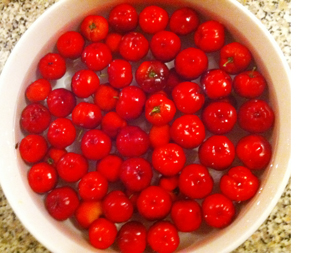
In accordance with permitted health claims it should be stated that:
- Rutin has a positive effect on the function of blood vessels (arteries, veins and capillaries), supports their health and elasticity and normalizes permeability through the blood vessel wall.
- Rutin has strong antioxidant properties and protects the body's cells against the harmful effects of free radicals.
- Rutin improves the functioning of the immune system.
Przepisy zabraniają nam opisać wszystkie właściwości rutyny (rutozydów) przy przedstawianiu preparatu, który jest suplementem diety. Dlatego podajemy odnośniki, gdzie osoby bardziej zainteresowane mogą z miarodajnych źródeł więcej dowiedzieć o działaniu i właściwościach rutyny. → Portal Farmaceutyczno Medyczny
Spożycie pokarmów zawierających rutozydy (rutynę) może być korzystnie dla naczyń krwionośnych. Nie bez znaczenia są również jego właściwości antyoksydacyjne (wymiatacz wolnych rodników). Więcej na temat działania rutyny można również przeczytać → poradnikzdrowie.pl
Hesperydyna - jest to glikozyd (7-rutozyd) flawanonu zwanego hesperetyną. Hesperydyna zaliczana jest do tak zwanych czynników kapilarnych P. Ich działanie biologiczne związane jest przede wszystkim z naczyniami włosowatymi.
|
Vitamin C is probably the best and most widely known vitamin. It performs many functions in the body, including: strengthens the immune system, prevents fatigue and overwork. Tutaj możesz więcej przeczytać → New Developments and Novel Therapeutic Perspectives for Vitamin C (pdf file) and → "O witaminie C obiektywnie" (plik pdf) |
Foods rich in rutin
Most vegetables and fruits contain some amount of bio-flavonoids, and the most common ones include rutin, apigenin, quercetin, and hesperidin. They are especially common in flowering plants. They most often occur as yellow pigments dissolved in the cell sap of flowers and leaves. They are less common in fruits and rarely in seeds.
Cereals and grains rich in rutin and/or heperidin
Ancient grains tend to be les processed than modern grains, like corn and wheat. Because of this, ancient grains have more vitamin, mineral, and fiber content. Including ancient grains in your diet may come with health benefits.
Ancient grains are a group of grains and pseudocereals (seeds that are consumed like grains) that have remained mostly unchanged for thousands of years.
They’re dietary staples in many parts of the world, such as China, India, Africa, and the Middle East. Today, ancient grains are becoming more popular in Western countries.
That’s because they tend to be less processed and pack more vitamins, minerals, and fiber than more widespread grains like corn, rice, and modern wheat. The ancient grains are an exceptionally rich source of rutin.
In addition, studies have linked ancient grain consumption to health benefits, such as lower heart disease risk, better blood sugar control, and improved digestion.
BUCKWHEAT
Buckwheat (Fagopyrum esculentum) or common buckwheat is a particularly rich source of flavonoids, it has anti-atherosclerosis properties and strengthens the veins. And finally, routine! The representative of flavonoids found in the largest amount in buckwheat is rutin.
AMARANTH
Species belonging to the genus Amaranthus have been cultivated for their grains for 8,000 years. Amaranth plants are classified as pseudocereals that are grown for their edible starchy seeds, but they are not in the same botanical family as true cereals, such as wheat and rice. The yield of grain amaranth is comparable to that of rice or maize.
Amaranth slowly releases sugars into the blood, which means that there is no such "panic" desire to eat. Amaranth is an excellent source of magnesium, iron and folic acid! Contains 5 times more iron than spinach or wheat. Does not contain gluten. It contains B vitamins and antioxidants - vitamins A, C and E. Due to the high fiber content, it has a positive effect on intestinal function. Amaranth seeds contain large amounts of squalene, which is a compound that inhibits cell aging.
QUINOA
Otherwise, Peruvian rice is also a very old grain. It comes from South America, where it has been cultivated for 3-5 thousand years. It was a staple food in the Inca state. She was called there the "mother of cereals". Quinoa is a source of high-quality protein, healthy fatty acids, many vitamins (thiamin, riboflavin, niacin, folic acid, vitamin A and E) and minerals (calcium, iron, a lot of magnesium, phosphorus, potassium, sodium, zinc). Quinoa seeds contain an exceptionally large amount of flavonoids, which means that they have antioxidant properties. Quinoa protein is one of the few plant proteins that contains all exogenous amino acids, i.e. those that are not synthesized in the body and must be supplied with food. It is worth including it in the diet of vegetarians and vegans. In addition, quinoa is a source of fiber, which lowers blood glucose levels. Therefore, it can be consumed by people struggling with diabetes. Quinoa does not contain gluten and is easily digestible. You could say it's cosmic groats! NASA is conducting research on it to determine its usefulness during long-duration crewed flights.
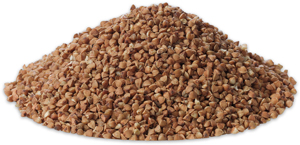 Kasza gryczana |
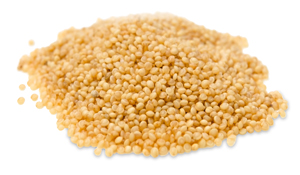 Amarantus ziarno |
 Komosa ryżowa |
Fruits rich in rutin
Najwięcej bioflawonoidów i wśród nich rutyny, jest zawarta w skórce i tuż pod jej powierzchnią. Dlatego aby dostarczyć organizmowi rutynę, to owoce należy spożywać ze skórką.
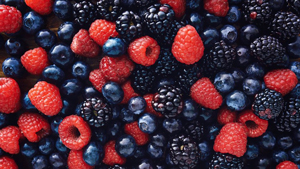
- Jabłka ze skórką
- Ciemne winogrona
- Owoc dzikiej róży
- Czarna porzeczka
- Cytrusy (cytryny, pomarańcze)
Vegetables rich in rutin
The main sources of flavonoids in the Polish diet are vegetables: onion, tomatoes, peppers and broccoli. Below we list vegetables with a high content of bioflavonoids, including rutin. It is also worth noting that both dark blue and dark green fruits and vegetables also provide anthocyanins and lutein - other than rutin, but also valuable bioflavonoids with a beneficial effect on the retina.
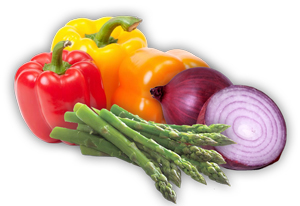
- Asparagus
- Onion
- Bell pepper red and green
- Tomatos
- Zucchini
- Broccoli
Herbs rich in rutin
Researchers (Kazimierczak et al) have demonstrated the presence of rutin in herbs - mint from organic cultivation, lovage, thyme and sage from both organic and conventional cultivation. Of the tested herbs, the most rutin contained organic mint and conventionally grown thyme. Interestingly, no rutin was detected in mint from conventional cultivation or in lemon balm from organic cultivation, while very small amounts of rutin were detected in lemon balm from conventional cultivation. It is also worth mentioning that, apart from rutoside, herbs were also rich in many other antioxidants, which is why dietitians recommend their use in meals.
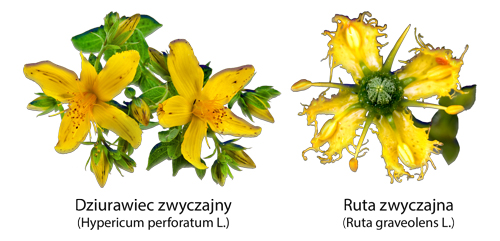
- Common rue (Ruta graveolens)
- St. John's wort (Hypericum perforatum)
- Elderberry flower (Sambucus)
- Thyme
- Sage (Salvia officinals)
- Mint (Menthe piperate)
- Marjoram (Origanum majorana)
References
Kazimierczak R, Hallmann E, Kazimierczyk M, Rembiałkowska E: Antioxidants content in chosen spice plants from organic and conventional cultivation; Journal of Research and Applications in Agricultural Engineering; 2010, Vol. 55(3).
Park BJ, Park JI, Chang KJ, Park CH.: Comparison in rutin content in seed and plant of tartary buckwheat (Fagopyrum tataricum). Proceedings of the 9th International Symposium on Buckwheat, Prague 2004: 626-629.
Samaszko-Fiertek J, Roguszczak P, Dmochowska B, Ślusarz R, Madaj J: Rutyna – budowa, właściwości; Wiadomości Chemiczne, 2016, 70, 7-8.
Content of bioflavonoids in selected plants
| Roślina/warzywo | Całkowite flawonoidy |
Kwercetyna | Katechina | Kemferol | Apigenia | Rutyna |
|---|---|---|---|---|---|---|
| Kapusta | ||||||
| Zielona papryka | ||||||
| Czerwona papryka | ||||||
| Marchew | ||||||
| Czerwony szpinak | ||||||
| Biała rzodkiew | ||||||
| Trawa cytrynowa | ||||||
| Kurkuma |
Wszystkie wyniki są średnia trzech pomiarów ± odchylenie standardowe. Wyniki wyrażone mg/g suchej masy. ND: non detected.



